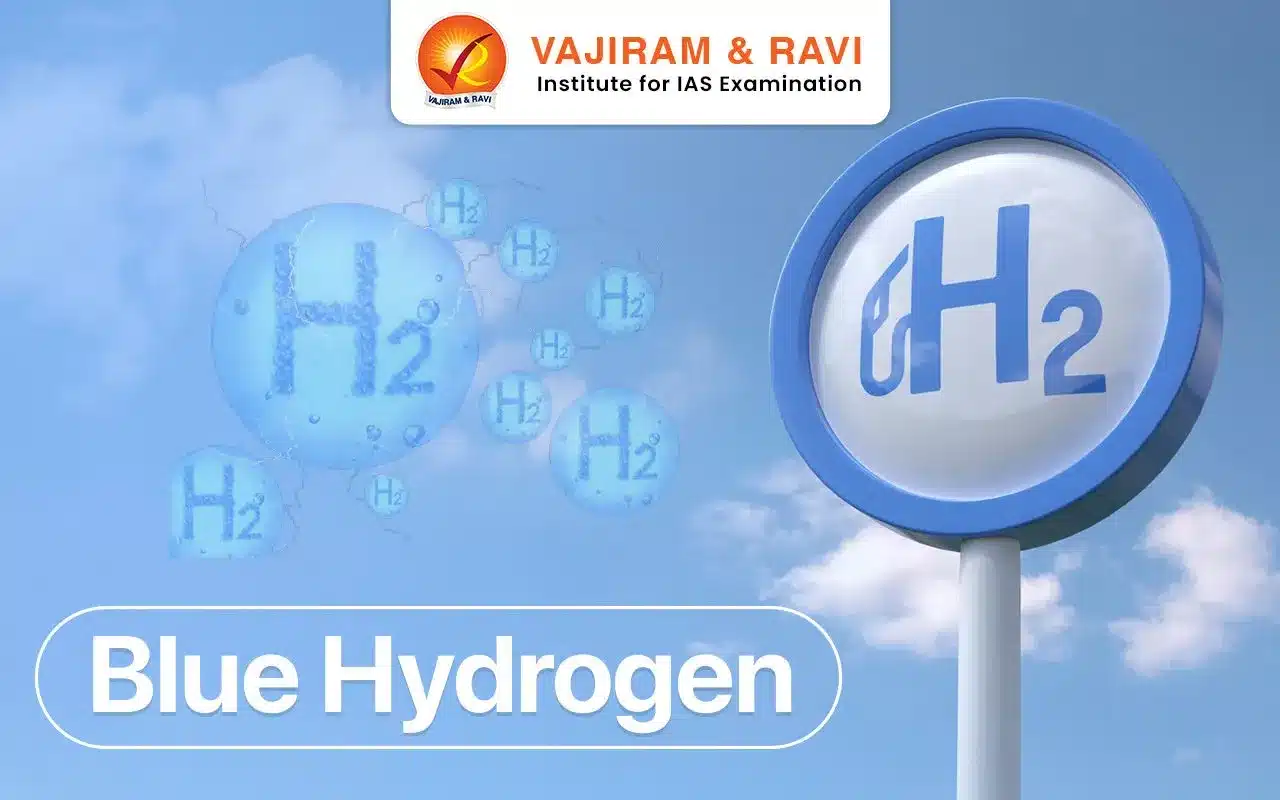Blue hydrogen refers to hydrogen produced from natural gas through a process called steam methane reforming (SMR), combined with carbon capture and storage (CCS) technology to reduce carbon emissions. It aimsto mitigate greenhouse gas emissions associated with traditional hydrogen production methods.
While not entirely carbon-free, blue hydrogen offers a lower-emission alternative to conventional fossil fuels, positioning it as a bridging solution as the world transitions towards more sustainable energy sources like green hydrogen.
About Blue Hydrogen
Depending on the nature of the method of its extraction, hydrogen is categorised into three categories, namely, Grey, Blue and Green.
Blue hydrogen is a form of hydrogen produced from natural gas using carbon capture and storage (CCS) technology. In this process, natural gas and heated water (steam) are combined, which produces hydrogen as the main output. However, carbon dioxide (CO2) is also produced as a by-product.
- The CO2 generated during this process is captured and stored underground, preventing its release into the atmosphere.
- Hence, blue hydrogen is a lower-emission alternative to natural gas and other fossil fuels.
Blue Hydrogen Production
To extract the blue hydrogen, the main processes include the Shell Blue Hydrogen Process (SBHP), steam methane reforming (SMR) and auto thermal reforming (ATR).
- Natural gas extraction: Natural gas is extracted from underground reservoirs through drilling and fracking operations.
- Hydrogen separation: The methane in natural gas is subjected to a chemical process, such as steam methane reforming or auto-thermal reforming, which separates the hydrogen molecules from the carbon atoms.
- Carbon Capture and Storage (CCS): The CO2 generated during the hydrogen production process is captured using various technologies such as absorption, adsorption, or membrane separation.
- The captured CO2 is then transported and stored underground in geological formations or depleted oil and gas reservoirs.
Blue Hydrogen Significance
Blue hydrogen holds a variety of uses and possibilities. It can act as a bridging fuel for current systems, particularly in areas where direct electrification might not be practical or economical. It offers several benefits:
- Lower emissions: Blue hydrogen produces significantly lower emissions compared to natural gas and other fossil fuels.
- The CCS technology captures and stores the CO2 generated during hydrogen production, preventing its release into the atmosphere.
- Compatibility with existing infrastructure: Blue hydrogen can be produced using existing natural gas infrastructure, making it a more cost-effective and efficient transition from fossil fuels to cleaner energy sources.
- Flexibility: Blue hydrogen can be used in various applications, including power generation, transportation, and industrial processes, making it a versatile energy source.
Blue Hydrogen Challenges and Limitations
Blue hydrogen faces several challenges and limitations, primarily related to its production process and environmental impact:
- Carbon capture efficiency: Achieving high capture rates is technically challenging and expensive. Current technologies may not capture all emitted CO₂.
- Methane leakage: Natural gas extraction and transport can result in methane leaks, a potent greenhouse gas that undermines the benefits of blue hydrogen.
- Energy intensity: The production of blue hydrogen is energy-intensive, requiring significant amounts of energy to extract natural gas and produce hydrogen.
- This can lead to increased greenhouse gas emissions and energy consumption.
- Competition with Green Hydrogen: Green hydrogen, produced using renewable energy sources like wind or solar power, is considered a more sustainable and environmentally friendly alternative to blue hydrogen.
- The competition between blue and green hydrogen may affect the adoption of either technology. Green hydrogen's cost is anticipated to decrease by 50% by 2030, aligning it with blue hydrogen costs by 2050.
Blue Hydrogen UPSC PYQs
Question 1: With reference to ‘fuel cells’ in which hydrogen-rich fuel and oxygen are used to generate electricity, consider the following statements : (UPSC Prelims 2015)
- If pure hydrogen is used as a fuel, the fuel cell emits heat and water as by-products.
- Fuel cells can be used for powering buildings and not for small devices like laptop computers.
- Fuel cells produce electricity in the form of Alternating Current (AC).
Which of the statements given above is/are correct?
- 1 only
- 2 and 3 only
- 1 and 3 only
- 1, 2 and 3
Answer: (a)
Last updated on December, 2025
→ Check out the latest UPSC Syllabus 2026 here.
→ Join Vajiram & Ravi’s Interview Guidance Programme for expert help to crack your final UPSC stage.
→ UPSC Mains Result 2025 is now out.
→ UPSC Notification 2026 is scheduled to be released on January 14, 2026.
→ UPSC Calendar 2026 is released on 15th May, 2025.
→ The UPSC Vacancy 2025 were released 1129, out of which 979 were for UPSC CSE and remaining 150 are for UPSC IFoS.
→ UPSC Prelims 2026 will be conducted on 24th May, 2026 & UPSC Mains 2026 will be conducted on 21st August 2026.
→ The UPSC Selection Process is of 3 stages-Prelims, Mains and Interview.
→ UPSC Result 2024 is released with latest UPSC Marksheet 2024. Check Now!
→ UPSC Prelims Result 2025 is out now for the CSE held on 25 May 2025.
→ UPSC Toppers List 2024 is released now. Shakti Dubey is UPSC AIR 1 2024 Topper.
→ UPSC Prelims Question Paper 2025 and Unofficial Prelims Answer Key 2025 are available now.
→ UPSC Mains Question Paper 2025 is out for Essay, GS 1, 2, 3 & GS 4.
→ UPSC Mains Indian Language Question Paper 2025 is now out.
→ UPSC Mains Optional Question Paper 2025 is now out.
→ Also check Best IAS Coaching in Delhi
Blue Hydrogen FAQs
Q1. What is blue hydrogen?+
Q2. How is blue hydrogen produced?+
Q3. What are the advantages of blue hydrogen?+
Q4. What are the challenges associated with blue hydrogen?+
Tags: blue hydrogen quest

















